Thrombin-induced neuronal protection: role of the mitogen activated protein kinase/ribosomal protein S6 kinase pathway
- PMID: 20846511
- PMCID: PMC2963703
- DOI: 10.1016/j.brainres.2010.09.025
Thrombin-induced neuronal protection: role of the mitogen activated protein kinase/ribosomal protein S6 kinase pathway
Abstract
Our previous studies have found that intracerebral pretreatment with a low dose of thrombin (thrombin preconditioning, TPC) reduces infarct volume and attenuates brain edema after focal cerebral ischemia. In this study, we examined whether TPC protects against the neuronal death induced by oxygen glucose deprivation (OGD), and whether the protection is through thrombin receptors and the p44/42 mitogen activated protein kinases (MAPK)/ribosomal protein S6 kinases (p70 S6K) pathway. Expression of protease-activated receptors (PARs) mRNA was detected in cultured primary rat neurons and thrombin upregulated PAR-1 and PAR-4 mRNA expression. TPC reduced OGD-induced neuronal death (e.g. dead cells: 52.5 ± 5.4% vs. 72.3 ± 7.2% in the control group, n=6, p<0.01). Agonists of PAR-1 and PAR-4 mimicked the effects of thrombin and reduced OGD-induced neuronal death. Pretreatment with thrombin or PAR agonists induced the upregulation of activated p44/42 MAPK and p70S6K (Thr 421/Ser 424). PD98059, an inhibitor of p44/42 MAPK kinase, blocked thrombin-induced upregulation of activated p44/42 MAPK and p70S6K. It also reduced TPC-induced neuronal protection (e.g. dead cells: 68.2 ± 5.2% vs. 56.9 ± 4.6% in vehicle+TPC group, n=6, p<0.05). These results suggest that TPC-induced ischemic tolerance is through activation of thrombin receptors and the p44/42 MAPK/p70S6K pathway.
Copyright © 2010 Elsevier B.V. All rights reserved.
Figures
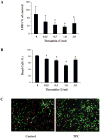

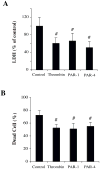

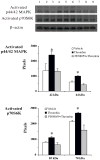
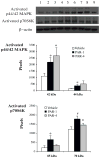
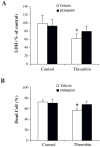
Similar articles
-
Thrombin preconditioning attenuates iron-induced neuronal death.Acta Neurochir Suppl. 2011;111:259-63. doi: 10.1007/978-3-7091-0693-8_43. Acta Neurochir Suppl. 2011. PMID: 21725765
-
Activation of p44/42 mitogen activated protein kinases in thrombin-induced brain tolerance.Brain Res. 2001 Mar 23;895(1-2):153-9. doi: 10.1016/s0006-8993(01)02064-9. Brain Res. 2001. PMID: 11259772
-
Thrombin-induced tolerance against oxygen-glucose deprivation in astrocytes: role of protease-activated receptor-1.Cond Med. 2018 Feb;1(2):57-63. Epub 2018 Feb 15. Cond Med. 2018. PMID: 30123875 Free PMC article.
-
Thrombin preconditioning reduces iron-induced brain swelling and brain atrophy.Acta Neurochir Suppl. 2011;111:219-23. doi: 10.1007/978-3-7091-0693-8_37. Acta Neurochir Suppl. 2011. PMID: 21725759
-
Endogenous protease nexin-1 protects against cerebral ischemia.Int J Mol Sci. 2013 Aug 14;14(8):16719-31. doi: 10.3390/ijms140816719. Int J Mol Sci. 2013. PMID: 23949634 Free PMC article.
Cited by
-
Effects of Thrombin on the Neurovascular Unit in Cerebral Ischemia.Cell Mol Neurobiol. 2022 May;42(4):973-984. doi: 10.1007/s10571-020-01019-6. Epub 2021 Jan 3. Cell Mol Neurobiol. 2022. PMID: 33392917 Free PMC article. Review.
-
Lymphocyte cell kinase activation mediates neuroprotection during ischemic preconditioning.J Neurosci. 2012 May 23;32(21):7278-86. doi: 10.1523/JNEUROSCI.6273-11.2012. J Neurosci. 2012. PMID: 22623673 Free PMC article.
-
Autoantibodies from Patients with Scleroderma Renal Crisis Promote PAR-1 Receptor Activation and IL-6 Production in Endothelial Cells.Int J Mol Sci. 2021 Oct 30;22(21):11793. doi: 10.3390/ijms222111793. Int J Mol Sci. 2021. PMID: 34769227 Free PMC article.
-
Baicalin protects against thrombin induced cell injury in SH-SY5Y cells.Int J Clin Exp Pathol. 2015 Nov 1;8(11):14021-7. eCollection 2015. Int J Clin Exp Pathol. 2015. PMID: 26823714 Free PMC article.
-
Role of protease-activated receptor-1 in brain injury after experimental global cerebral ischemia.Stroke. 2012 Sep;43(9):2476-82. doi: 10.1161/STROKEAHA.112.661819. Epub 2012 Jul 17. Stroke. 2012. PMID: 22811450 Free PMC article.
References
-
- Berven LA, Crouch MF. Cellular function of p70S6K: a role in regulating cell motility. Immunol Cell Biol. 2000;78:447–51. - PubMed
-
- Cannon JR, Keep RF, Hua Y, Richardson RJ, Schallert T, Xi G. Thrombin preconditioning provides protection in a 6-hydroxydopamine Parkinson’s disease model. Neurosci Lett. 2005;373:189–94. - PubMed
-
- Cannon JR, Keep RF, Schallert T, Hua Y, Richardson RJ, Xi G. Protease-activated receptor-1 mediates protection elicited by thrombin preconditioning in a rat 6-hydroxydopamine model of Parkinson’s disease. Brain Res. 2006;1116:177–86. - PubMed
-
- Chan MT, Boet R, Ng SC, Poon WS, Gin T. Effect of ischemic preconditioning on brain tissue gases and pH during temporary cerebral artery occlusion. Acta Neurochir Suppl. 2005;95:93–6. - PubMed
Publication types
MeSH terms
Substances
Grants and funding
LinkOut - more resources
Full Text Sources
Miscellaneous

